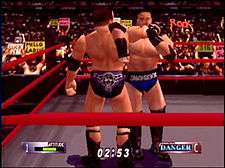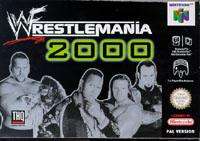WWF WrestleMania 2000
| WWF WrestleMania 2000 | |
|---|---|
|
European Nintendo 64 cover art featuring The Big Show, Mankind, The Rock, Triple H, and The Undertaker | |
| Developer(s) |
Asmik Ace Entertainment AKI Corporation (Nintendo 64)[1] Natsume (Game Boy Color) |
| Publisher(s) | |
| Distributor(s) | THQ |
| Composer(s) |
Kouji Niikura (N64) Yukie Sugawara (N64) Iku Mizutani (GBC) |
| Platform(s) |
Nintendo 64 Game Boy Color |
| Release date(s) |
Nintendo 64 |
| Genre(s) |
Professional wrestling[1] Fighting[1] |
| Mode(s) |
Single player multiplayer |
WWF WrestleMania 2000 is a professional wrestling video game originally released in 1999 on the Nintendo 64 (N64) console. It was based on the World Wrestling Federation's annual pay-per-view, WrestleMania Despite the fact that this game is based upon Wrestlemania 2000 the game was released 5 months prior (Game Boy Color 4 months prior), to the actual PPV itself, therefore resulting in using Wrestlemania from that year instead (WrestleMania XV). Released at the height of the WWF's Attitude Era, WrestleMania 2000 was the first WWF game released by THQ. The wrestling company ended its long relationship with Acclaim Entertainment after witnessing the video game success of its competitor, World Championship Wrestling, on behalf of THQ.[2] WrestleMania 2000 shares its game engine with the Japan-only release Virtual Pro Wrestling 2: Ōdō Keishō.
The game would be succeeded by WWF No Mercy in 2000.
Gameplay
WrestleMania 2000 uses the game engine previously seen in WCW/nWo Revenge. More than 50 WWF wrestlers were included in the game, and, with the exception of existing superstars' move sets, all of them can be edited to the player's liking. Using the same system, the Create-a-Wrestler mode is extensive. The player is able to create a highly detailed wrestler with an extensive library of wrestling moves. Usual WWF modes such as Royal Rumble and King of the Ring modes are included, along with a pay-per-view mode, enabling the player to either recreate or create unique pay-per-views with TV-style features. Players can also create up to eight belts and put them up for contest.
The story mode places the player on the long road to WWF glory. Starting out as a rookie, the player gradually works his way up the ladder and earns opportunities to gain various WWF titles, win various tournaments, be challenged by various wrestlers and ultimately main-event at WrestleMania 2000. Although the story mode is long and extensive in the amount of matches in which it pits the player, there are no branching story lines and if the player loses a match it is simply recorded as a loss in their win-loss record. In fact, wrestlers are expected to defend each title in pay-per-view events. For example, if one holds the European Championship, Intercontinental Championship, WWF Tag Team Championship, and the WWF Title, the player must defend all four in one pay-per-view event.
There are often feuds at different parts in the storyline, occasionally with one wrestler calling out another wrestler in the ring. Also, feuding wrestlers often interrupt matches, helping the opponent. However, the season continues whether or not the player wins or loses matches. If the player progresses through a winning season with a created wrestler and then starts a new season as a new created wrestler, the first character will still be used in season mode.
Features

The game features several arenas that WWF held events at in 1998 and 1999. There are also arenas based on each WWF television show, such as the Sunday Night Heat, Raw is War, and also including other venues (correct Pay Per Views of the time).
This was the first WWF game to allow players to edit their favorite superstars (i.e. putting the Big Boss Man in Ken Shamrock's trunks) and also be able to create alternate attires for each wrestler, as each character in the game has four templates that can be individually edited and switched between using the left and right 'C' buttons. If the player make changes that he or she doesn't like, a default button puts the original costume in the slot they were using. It was also the first THQ produced Nintendo 64 title to feature a "Create a Wrestler" mode.
In addition to the numerous default and secret characters, several other realistic likenesses and movesets in the create-a-wrestler mode make it possible to add even more characters. Some examples include The Road Warriors, Hulk Hogan, Taka Michinoku, and Davey Boy Smith. Also, some taunts and move sets were carried over from WCW/nWo Revenge, allowing the player to create and include WCW wrestlers such as Goldberg, Kevin Nash, Scott Hall, Diamond Dallas Page, and Macho Man Randy Savage. The drawback to the create-a-wrestler mode is the fact that there are limited slots available due to memory space, but players can edit the individual templates in the character models to include four different characters with separate appearances which allows a great deal of flexibility. However, wrestler in the same template are forced to have the same moves.
Additionally, by making two superstars' entrance music the same, if they are a real-life tag team they will be introduced as such; for instance, matching the Road Dogg and Mr. Ass's themes would lead to them being introduced together as The New Age Outlaws before a tag team match.
Also, some features are implemented in the game that weren't seen in WCW/nWo Revenge, such as a Cage Match and a First Blood mode. Reversals and counter moves were also made much more commonplace.
A normally unselectable Computer Intelligence mode can also be accessed using a GameShark code, as well as WCW and nWo ring aprons.
Signature taunts
In WWF Wrestlemania 2000, many players have their signature taunts, such as Stone Cold Steve Austin flipping off an opponent or Mr. Ass mooning another wrestler. Also, by pressing in a different direction on the joystick, a different taunt is performed. Rotating the joystick counter clock wise results in the player mimicking his opponent's taunt.
Roster
- Stone Cold Steve Austin
- The Rock
- Mankind
- Triple H
- The Undertaker
- Kane
- Big Show
- X-Pac
- Road Dogg
- Billy Gunn
- Ken Shamrock
- Chris Jericho
- Vince McMahon
- Shane McMahon
- Big Bossman
- Test
- Godfather
- Val Venis
- D'lo Brown
- Mark Henry
- Jeff Jarrett
- Farooq
- Bradshaw
- Edge
- Christian
- Gangrel
- Matt Hardy
- Jeff Hardy
- Al Snow
- Hardcore Holly
- Droz (wrestler)
- Prince Albert
- Steve Blackman
- Chaz
- Thrasher
- Mideon
- Viscera
- Meat
- The Blue Meanie
- Brian Christopher
- Scott Taylor
- Chyna
- Tori
- Debra
- Ivory
- Jacqueline
- Terri Runnels
- Pat Patterson
- Gerald Brisco
- Michael Hayes
Hidden characters
- Shawn Michaels
- Cactus Jack
- Dude Love
- Jim Ross
- Jerry Lawler
- Paul Bearer
- Stephanie McMahon
- Dummy (GameShark)
- Hos (GameShark)
Advertising and release
In a TV commercial promoting the game, The Rock becomes furious at how the game includes his name, likeness, and move-set. At the end of the ad, he threatens to shove copies of the game up Santa Claus's "candy-ass."
Some copies of WWF WrestleMania 2000 shipped with a special card containing four holograms of the in game action, such as a wrestler's entrance or finishing move.
Reception
| Reception | |||||||||||||||||||||||||||||||||||||||||
|---|---|---|---|---|---|---|---|---|---|---|---|---|---|---|---|---|---|---|---|---|---|---|---|---|---|---|---|---|---|---|---|---|---|---|---|---|---|---|---|---|---|
| |||||||||||||||||||||||||||||||||||||||||
The N64 version of the game received "favorable" reviews, while the Game Boy Color version received "mixed" reviews, according to video game review aggregator GameRankings.[16][15]
In the final edition of Nintendo Power, WWF WrestleMania 2000 was ranked number 223 in a list of the best games released on Nintendo consoles, namely for its massive roster and positive game-play ability. The game is still considered to be one of the best wrestling games of all time.
See also
References
- 1 2 3 4 5 6 "WWF Wrestlemania 2000 Release Information for Nintendo 64". GameFAQs.
- ↑ McLaughlin, Rus (November 12, 2008). "IGN Presents the History of Wrestling Games (Page 4)". IGN. Retrieved February 19, 2015.
- ↑ Ottoson, Joe. "WWF Wrestlemania 2000 (GBC) - Review". AllGame. Archived from the original on November 15, 2014. Retrieved February 19, 2015.
- ↑ Ottoson, Joe. "WWF Wrestlemania 2000 (N64) - Review". AllGame. Archived from the original on November 15, 2014. Retrieved February 19, 2015.
- ↑ "WWF Wrestlemania 2000 (N64)". Electronic Gaming Monthly. 1999.
- ↑ Mears, Rick "The Wanderer" (November 8, 1999). "REVIEW for Wrestlemania 2000 (N64)". GameFan. Archived from the original on November 27, 1999. Retrieved February 19, 2015.
- ↑ Fitzloff, Jay (January 7, 2000). "WWF WrestleMania 2000 - Game Boy Color". Game Informer. Archived from the original on October 26, 2000. Retrieved February 19, 2015.
- ↑ McNamara, Andy; Fitzloff, Jay; Reiner, Andrew (November 25, 1999). "WWF WrestleMania 2000 - Nintendo 64". Game Informer. Archived from the original on October 25, 2000. Retrieved February 19, 2015.
- ↑ The D-Pad Destroyer (November 18, 1999). "Wrestlemania 2000 Review for N64 on GamePro.com". GamePro. Archived from the original on November 6, 2004. Retrieved February 19, 2015.
- ↑ Dodson, Joe (March 2000). "WWF Wrestlemania 2000 Review (N64)". Game Revolution. Retrieved February 19, 2015.
- ↑ Gerstmann, Jeff (November 12, 1999). "WWF Wrestlemania 2000 Review (N64)". GameSpot. Retrieved February 19, 2015.
- ↑ Harris, Craig (December 8, 1999). "WWF Wrestlemania 2000 (GBC)". IGN. Retrieved February 19, 2015.
- ↑ Boulding, Aaron (November 24, 1999). "WWF Wrestlemania 2000 (N64)". IGN. Retrieved February 19, 2015.
- ↑ "Wrestlemania 2000 (N64)". Nintendo Power. 127: 155. December 1999.
- 1 2 "WWF Wrestlemania 2000 for Game Boy Color". GameRankings. Retrieved February 19, 2015.
- 1 2 "WWF Wrestlemania 2000 for Nintendo 64". GameRankings.
External links
- WWF Wrestlemania 2000 (Nintendo 64) at MobyGames
- WWF Wrestlemania 2000 (Game Boy Color) at MobyGames
